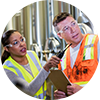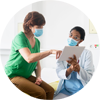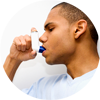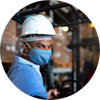Getting the Workforce Back to Work
In this webinar, you will learn about:
- Return-to-work testing and COVID-19 clearance
- Surveillance of moderate- to high-risk workforces and jobs
- Concentra Telemed® service enhancements
- Q&A
Presented by:
John Anderson, DO, FACOEM, chief medical officer, executive vice president
Ronda McCarthy, MD, MPH, FACOEM, national director of medical surveillance services
Lisa Figueroa, MD, FACEP, vice president of medical operations, national medical director of health information technology, and national medical director of telemedicine
Host
0:03
Hello, everyone, and welcome to the Concentra webinar, “Getting the Workforce Back to Work.” Today’s webinar will be presented by Concentra’s Chief Medical Officer Dr. John Anderson, Dr. Ronda McCarthy, national director of medical surveillance services, and Dr. Lisa Figueroa, national medical director for telemedicine at Concentra. At the conclusion of the presentation, we will have a 10-to-15-minutes Q&A session. You can submit your questions throughout the presentation. During the Q&A, we will answer as many questions as possible within the time allowed. A recording of the webinar will be emailed to you after the presentation so you can listen to it again at your convenience.
Dr. Anderson, we’re ready to begin.
Dr. John Anderson
0:50
Thank you. We’ll address a number of things on the agenda today, including:
- Preparing for America’s Reopening
- COVID-19 Clearance Assessment, Surveillance, and Return to Work
- Why Telemedicine?
- About Concentra Telemed
- Q&A
Somebody asked me yesterday how I was faring in this fluid environment. We continuously hear of this environment as fluid. My response was I feel like it’s so fluid that I’m drowning in information. The good news is that over the last three weeks, we’re finally seeing some decreases in the number of specimens testing positive for the coronavirus nationally, the number of national emergency department visits for bouts of influenza-like illness, and coronavirus-like illness, and also the percentage of deaths attributed to pneumonia, influenza, and coronavirus. So that’s pretty good news. And now, as the federal, state, and local governments begin to loosen the restrictions on businesses, it’s really crucial for those of us responsible for reopening our businesses to prepare and move forward in a logical and safe manner. It is difficult to do with all the information coming at us from all sides.
Over the next hour, we will address some of the challenges we’re all facing, Concentra included, in returning to some sense of normalcy or the new normal, and maybe some of the solutions we believe that will help bring employees back to work, while at the same time promoting a healthy work environment.
Protecting vulnerable employees from COVID-19
We all need solutions that control the presence and spread of the coronavirus to healthy employees and that also promote confidence in your employees that their safety is your highest priority when returning them to work.
This is particularly true for those who are vulnerable to the most serious complications of the coronavirus. As we’ve seen on television for the past several months, this vulnerable group includes an estimated 41 million individuals in the working population between the ages of 18 to 65 who have serious underlying health conditions. It also includes everyone over 65 years of age because age is a risk factor, in and of itself. Identifying those vulnerable employees is one of the many factors that our clinicians take into consideration in the process of determining appropriate return-to-work recommendations. We need solutions that are cost-effective, time-sensitive, reliable, convenient, and safe for your employees.
We’ve been working for the past several months on those options, knowing that this time would come soon and would involve literally millions of employees returning to their jobs. We know from talking to some of you that there are many employers struggling to make decisions based on the overload of information and guidance from the CDC, the World Health Organization, and OSHA – information that sometimes changes daily, and at times also appears to be contradictory. On top of that, the deluge of misinformation about products, tests and programs is truly confusing at best. So we hope today to bring you some level of clarity and simplicity that will make your decisions easier as you reopen your workplace.
Next slide. [How Employers Can Reduce Risk in the Workplace]
Reducing risk of COVID-19 in the workplace
4:30
There are a number of different things that we and the CDC recommend that are so helpful and fundamental, and yet the most important advice for strategies that can help prevent and reduce workplace exposures to the coronavirus, as well as other infectious diseases. We’re living in a changed world now and we appreciate the advice of Benjamin Franklin. He said that an ounce of prevention is worth a pound of cure. Encourage your sick employees to stay home and ensure your sick leave policies allow this. At the same time, encourage those coming back to work to get physically prepared and in condition for the job that they left behind. Ensure that your employees understand correct respiratory etiquette, hand hygiene, social distancing, and provide health resources to them, as needed, posted around the workplace. Regularly clean and disinfect the work environment, especially those frequently touched surfaces we’ve heard about on the news: doorknobs, door handles, surface tops, and so forth. Create an infectious disease outbreak response plan and share it with your employees. That doesn’t pertain to only COVID-19 but other potential infectious disease outbreaks, as well, including influenza.
Next slide. [COVID-19 Business Impact]
Concentra is prepared to serve employers
What has Concentra been doing all this time to respond to the coronavirus? Number one starts with us at the very front door. We ask that patients entering the front door and visitors all wear a mask. We have an enhanced clinical triage process that detects potential COVID-19 cases entering into the center. So that these cases won’t get past our front door, we have a mandatory screening questionnaire for every person and at every center to isolate those people. We also immediately, once identified, separate the sick from the healthy and place them in an isolation room to reduce the possible spread of coronavirus. We're cleaning and using infection control processes throughout our centers in every single room. And, in the early stages of the coronavirus pandemic, we developed a coronavirus task force with subject matter experts to stay ahead of the curve with the coronavirus issues involving our centers and our patients. We've implemented testing for coronavirus.
7:12
We have a new clearance assessment, which is an online, or available online, questionnaire for patients to fill out, which is then reviewed by our clinicians to determine whether or not they are ready to return to the workplace without increasing contagion at the worksite. We perform COVID-19 RNA and antibody clearance along with return-to-work testing now provided for asymptomatic employees. I'll make a point here of saying that patients coming into our centers need to be asymptomatic. We are not taking care of symptomatic employees nor are we testing symptomatic employees.
We have ongoing COVID-19 surveillance screening programs and testing now available. And, finally, the expansion of our telemedicine program from our core telemedicine group of dedicated physicians to every one of our centers. That has occurred over the past several weeks. New telemedicine services that are available include COVID-19 return-to-work evaluations and also transfer of care evaluations.
Next slide. [Concentra is Ready to Safely and Effectively Support Return to Work]
New services from Concentra
Now I would like to introduce Dr. McCarthy, who is Concentra’s national medical director for medical surveillance services and also the chair of our regulatory testing and examinations medical expert panel. Dr. McCarthy...
Dr. Ronda McCarthy
8:50
Thank you, Dr. Anderson. As Dr. Anderson introduced, Concentra medical centers will offer new services that are vetted through Concentra’s coronavirus task force to clear your employees back to work safely and effectively while keeping our own colleagues safe. These services have become possible with personal protective equipment, such as face mask and N95 respirators supplies catching up to demand. Also, Concentra now offers two quality FDA-emergency use-authorized COVID-19 tests.
The new service offerings are specifically for initial clearance of workers back into the work environment, ongoing COVID-19 Workforce surveillance, and COVID-19 return-to-work evaluations for employees with exposure to COVID-19 or return to work after presumed or confirmed illness, as Dr. Anderson just discussed. These services are all for asymptomatic employees. There is no change to our current screening protocol of triaging all patients entering into Concentra centers.
Next slide. [Concentra COVID-19 Services]
This slide outlines the COVID-19 services available to clear employees after furlough and may also be used by some employers whose employees are already working. The service package options you choose may depend on local and state mandates, employer policy, and worksite coronavirus exposure risk. The first option the COVID-19 clearance assessment. It is the most cost effective and time-efficient option. This assessment is included in all in all the other clearance service packages.
The next option is the COVID-19 clearance active infection and antibody initial test. This is our most comprehensive service for the risk-averse employer. It will let the employers know if their employees have active infection or have presumed immunity to SARS-COVID-2.
The COVID-19 clearance antibody and clearance active infection testing includes the comprehensive screening and either the antibody or the active infection test. If the antibody test is included this service will not provide any testing confirmation for active infection and should not be used alone to determine if an individual is actively infected or in contagious. If the clearance active infection service package is used, it will determine if an individual or the individuals tested are actively infected or contagious.
These clearance evaluations may also be combined with active infection surveillance, which monitors your workforce that has returned for active COVID-19 infection on a periodic basis. The tests on initial clearance only screen and test for infection at that point in time. You will need ongoing monitoring and testing at the worksite to determine ongoing active infection.
Our return-to-work evaluation is also available for those employees who may develop infection while at work or be exposed to COVID-19 at the workplace or at home and need a return-to-work evaluation prior to return to work.
Clinical pathway for new COVID-19 work clearance solutions
Next slide. [Solutions]
This solutions flowchart of the COVID-19 services represents the clinical pathway for each offering and the associated costs. As stated previously, the coronavirus clearance assessment purpose is to provide medical clearance of furloughed employees back into the work environment in a safe, cost-effective, and time-efficient manner. The clearance decisions are based on employees’ response to four categories of questions. Occupational history. Medical and risk factors. We ask about recent COVID-19 exposure and COVID-19 illness history. Those employees who have no health history, no risk factors, no exposure history, and no history of COVID-19 disease will be recommended to work without restriction. They pose no known risk to follow workers. Those employees that answered differently may be asked to come into the clinic for further evaluation or come in for a test, depending on the information provided. So, if you look at the solution and look at row A, you can see that you'll have assessment, which is the form with the questions just discussed, and you'll have the clinician review. This may go directly to where we advise work or home if they happen to have symptoms of illness or exposure, and we do not recommend they return at that time. Or they may be advised for a clinical exam or specifically an RNA test or an antibody test. The B, C, and D options represent the service packages that we discussed where the employer may want the assessment and the RNA test only or both the RNA and antibody tests. Service package E is with an in-house examination, such as the return-to-work offering, if you have an employee that is that has had an exposure and/or an illness and needs a return-to-work evaluation.
Next slide. [Types of COVID-19 Tests]
Types of COVID-19 tests, accuracy, and limitations
14:54
Let's look at COVID-19 testing options more closely. The RNA test is used to determine if someone is currently infected with SARS-COVID-2, the virus that causes COVID-19. At Concentra, we use a nasal swab to collect the specimen. This specimen is processed in the nationally recognized laboratory, Quest. The turnaround time is two to three days from the date of collection. The COVID-19 antibody test is a blood test and it's used to determine If someone has had the infection and is presumed immune. It is also processed by Quest. Its turnaround time is three to four days. Your employee can expect Concentra medical staff to wear the appropriate personal protective equipment when collecting specimens. We also ask that all patients wear a mask while in Concentra centers.
Next slide. [Accuracy of Tests and Limitations That Apply to All COVID-19 Testing]
Although Concentra utilizes thoroughly vetted testing procedures and quality laboratories, there are limitations to COVID-19 RNA and antibody testing. No test is 100 percent accurate all the time, but testing remains our best tool to identify infection. For the COVID-19 RNA test, the limitation is primarily false negatives. False positives are possible, but a positive RNA test is likely indicative of COVID-19 infection. If you have a negative test, an employee may actually have COVID-19 infection. So, if they have symptoms that that are indicative of a COVID-19 infection, we may want to repeat that. A positive COVID-19 antibody test indicates the presence of antibodies for some level of protection from the virus, at least in the short term at our present knowledge of this antibody test. How long this protection lasts and whether or not it declines over time are still unknown. A negative antibody test means antibodies are not pleasant at detectable levels, but it does not rule out the possibility of previous COVID-19 infection. Again, false negatives are more likely to occur than false positives with the antibody test.
Next slide. [About COVID-19 Services]
So, about our services. Employers have 520 multiple points of access to Concentra centers nationwide. Worksite options are also available. COVID-19 services can remain as a single source of care for results and reporting all delivered the same way as your current services. Most importantly, the SARS-COVID-2 COVID-19 pandemic has increased everyone’s awareness on how important it is to identify and control employees’ exposure risk and for employers to provide ongoing management to provide for workplace health and safety. I will now pass the presentation on to Dr. Figueroa, our national medical director for telemedicine services, vice president of medical operations, and national medical director for health information technology. Thank you. Dr. Figueroa...
Concentra’s COVID-19 services include telemedicine expansion
Dr. Lisa Figueroa
18:08
Thank you, Dr. McCarthy. Good afternoon, everyone. So this slide is entitled Why Telemedicine? I think, in today's times, it probably is more appropriate to say Why Not Telemedicine? As the COVID-19 pandemic raged across America and across the world, telemedicine became a huge opportunity for patients to connect with their clinicians. Utilization of telemedicine increased radically during the COVID-19 pandemic. We know that many studies have revealed that telemedicine visits with patient- clinician interaction is perfectly appropriate for many visits, illnesses and work injuries alike. So telemedicine is an option to provide care to patients who are risk-adverse and don’t want to present to a center because they are concerned about potential exposure to COVID-19. Many cancellations of appointments, many no-shows of appointments occurred because employees were afraid to see their clinicians. That fear did not necessarily mean that that patient did not require care. Lots of people needed to see their clinicians but were not doing so because of the fear of exposure to COVID-19. So telemedicine certainly became a huge opportunity for patients to connect with their clinicians. We know in group health space that telemedicine adoption and utilization were on the rise, especially over the last five years, but the workers comp side was a little slower to adopt telemedicine.
19:51
Concentra has been providing telemedicine care for workers comp injuries for three-plus years now. But as the COVID-19 pandemic rages across the world, we certainly know that many workers comp injuries that occur in the workplace can be treated through telemedicine visits. We've shown that and proven that with Concentra Telemed®. Also the patients enjoy telemedicine visits and rate them highly.
Next slide, please. [About Concentra Telemed]
About Concentra Telemed. Certainly with the COVID-19 pandemic, the centralized core telemedicine team saw a vast increase in visits over a short period of time. It was actually a quadrupling in our visits within three days. Certainly the need was there, and Concentra responded by saying, how can we provide telemedicine care in our 520-plus centers across the nation and have our Concentra clinicians – local clinicians – provide the care employers value and provide it to employees via telemedicine across all of our centers. So very rapidly we were able to provide telemedicine to our patients. That included new injuries and injury rechecks. Those patients who were not presenting for their recheck appointments because of the fear of potential exposure, who were not showing up or were canceling. We reached out to them and said, how about a telemedicine visit with your clinician. Lo and behold, telemedicine was very well received, and we started to see telemedicine visits increase. We introduced telerehab so we could perform virtual visits for our therapy patients. Providing that service across all of our centers proved to be invaluable.
Concentra Telemed care quality is identical to in-center care
22:10
Using Concentra Telemed is like visiting a Concentra medical center. The reason I say that is because we use all of our applications that we currently do in centers via telemedicine. Our practice management system is the same. The employee virtually checks into our practice management system. Our Concentra center clinician conducts the visit with the patient, and the employer receives the same reporting and billing as if the employee were physically present in a center for the visit.
We’re utilizing Concentra telemedicine services in our centers nationwide during Concentra center hours.
Core Concentra telemedicine services continue
We still have our core centralized Concentra Telemed group that sees workers comp injury patients and illness patients 24/7, 365 days a year in 38 states now and including this District of Columbia. If you need to know which states are included, you can visit Concentra.com/telemedicine. So about Concentra Telemed, we all know that not every work injury is appropriate for telemedicine. This is based on mechanism of injury. Somebody who falls 20 feet from a roof is a case that’s likely not a candidate for a telemedicine visit. But many injuries are, so we look at injuries like the grade one and two upper and lower extremity sprains and strains, minor burns, back strains, neck strains and sprains, and those without significant limitations and movement. Telemedicine can handle contusions without deformities, occupational dermatitis, tendonitis, repetitive use injuries, and bloodborne pathogen exposures. These are all visits that are appropriate for telemedicine virtual care with the same quality of care that patients would receive if they went to a local Concentra center to see the local clinician that they have built relationships with, the clinicians they know and trust.
24:30
We also, as I mentioned, have rechecks and physical therapy, in addition to the telemedicine service offerings that I just mentioned. We also have COVID-19 return-to-work evaluations for asymptomatic employees who want to return to work but need a return to work evaluation. These are employees who have either had the illness or been exposed to COVID-19 and currently are asymptomatic and need that return to work. These are employer-paid services that are available via telemedicine.
Dr. Anderson briefly mentioned transfer of care of evaluations. These are workers comp patients who have been treated outside of Concentra but need care because, perhaps, those provider locations have closed and are no longer in business or have very limited hours. We are accepting workers comp patients in a transfer of care but those have to be reviewed and approved by a Concentra physician. And once that happens, those visits can be conducted in person or via telemedicine.
The billing process for Concentra Telemed services is identical to our medical center process. The difference is the bill will have a 95 modifier and a new location code that indicates that that visit was not in person but was conducted via telemedicine. There are no upcharges for telemedicine services and no contracts required from our current customers. There are no implementation fees, no coordination fees, no technology fees, and no language line fees if those are necessary for interpretation and translation services. Again, billing arrangements are the same as you would experience following an in-center visit.
Communicating to employers via portal
26:33
So how we communicate with our employers is also identical to the way it's done in-center. Current employers that are utilizing the employer portal to receive information – the work status, the activity status restriction form and the no-show reports – via the portal would continue to receive the same with telemedicine visits. Again, they are identical systems that we're using – our practice management system, our EHR – and so the communication to employers is identical to an in-person visit. All of that activity occurs via the portal or if you, as the employer, have identified a different mode of communication, we would provide it the same way for both telemedicine and in-person visits.
Let's talk about Concentra Telemed and four different categories: convenience, care quality, security, and integration. So certainly we know the convenience factor is there. Patients can conduct a visit using their smartphone, tablet or computer. They access Concentra Telemed and have a virtual visit with a clinician. It's the same quality of care as a visit in-person. The only difference is that the patient is not physically in-center, but on camera. All of our telemedicine visits are synchronous. That means a telemedicine visit is both video and audio. We’re not doing telephonic-only visits. For workers comp, these are video/audio synchronous visits and the same quality of care is delivered via telemedicine as in-person.
As for security, we use a HIPAA-compliant video telemedicine platform. Patient records are documented in our EHR. They are not documented on the video platform. That helps with the continuity of care. If a patient was seen in-center, all of the records are in our EHR. If they choose to have their recheck visit via telemedicine, all of that information is available in our EHR. Video visits are not recorded. That's an often asked question. They are not recorded on our video platform. As far as integration is concerned, again, because we have our same reporting, billing and EMR systems, it’s seamless and that information is integrated with our Concentra medical centers. There are no additional providers to manage. We utilize our own Concentra clinicians for all of our telemedicine services.
Accessing Concentra’s center-based telemedicine services
Next slide. [How to Access Center Telemedicine]
29:18
Center telemedicine is immediately available for current Concentra customers. No setup is required. Employees must have access to a private location. Employees determine what they consider private. If they are in their living room, and they have a significant other with them but still consider that private, that is a private location.
We ask all patients if they are in a private location, and we also make sure that they consent to telemedicine care with each visit. They have to have an internet-enabled device with a webcam and a microphone. Again, a smartphone, tablet or computer is all that’s required. To use telemedicine, employees should call his or her local Concentra medical center and request a telemedicine visit with a center clinician. Once that is done, the center staff will help the employee create an account on Concentra Telemed and set up a visit for them to be seen virtually with a Concentra clinician.
With that, I will turn it over to our moderator for the Q&A session.





